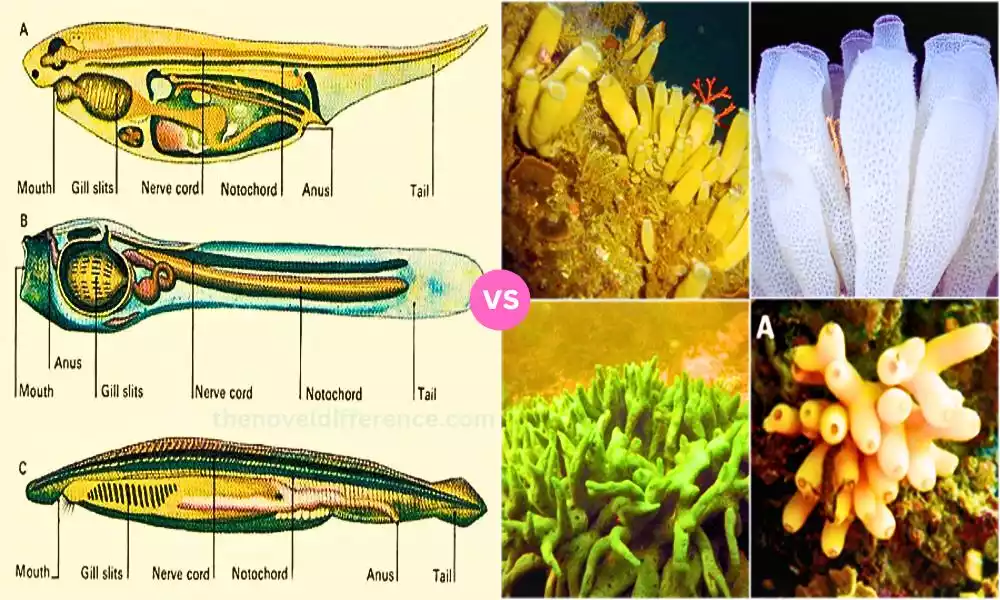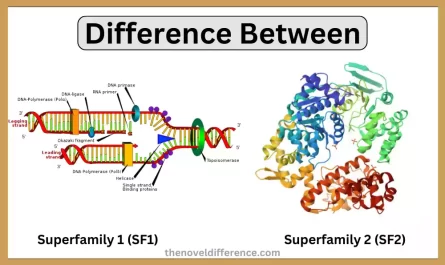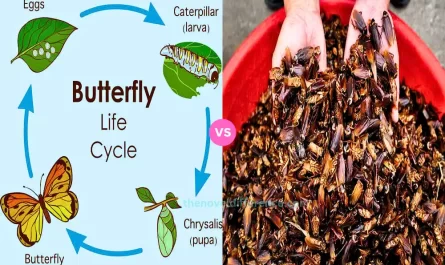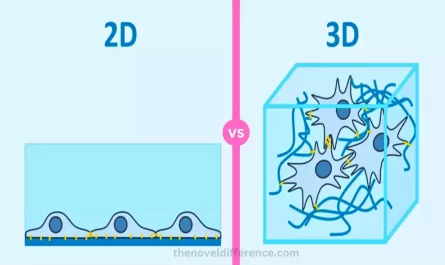A critical distinction between chordates and non-chordates lies in their body structures – chordates have a spinal cord or backbone, whereas non-chordates lack it and contain notochord.
Definition of Chordates and Non Chordates
Chordates: Chordates are a phylum of animals that possess a distinct set of anatomical features at some stage in their life cycle. These features include a notochord, a dorsal hollow nerve cord, pharyngeal slits or pouches, and a post-anal tail.
The notochord is a flexible rod-like structure that serves to support vertebrate bodies while acting as its precursor. The dorsal hollow nerve cord is a neural tube that develops into the central nervous system.
Pharyngeal slits or pouches are openings in the pharynx that serve varying functions depending on species; filter-feeding and respiration are two common functions. The post-anal tail is an extension of the body beyond the anus and is involved in locomotion and balance.
Chordates include diverse organisms, ranging from primitive sea creatures like tunicates and lancelets to more complex vertebrates like fish, amphibians, reptiles, birds, and mammals.
Non-Chordates: Non-chordates (also referred to as invertebrates) constitute an extremely diverse class of animals that do not share the distinguishing features characteristic of chordates. They lack a notochord, dorsal hollow nerve cord, pharyngeal slits or pouches, and a post-anal tail.
Non-chordates encompass a wide range of animal phyla, exhibiting diverse body plans, anatomical structures, and ecological roles. Wildlife species make up most of Earth’s species of animal life and can be found living in various ecosystems including freshwater, marine, and terrestrial environments.
Non-chordate animals include Porifera (sponges), Cnidaria (jellyfish, corals, and anemones), Platyhelminthes (flatworms), Annelida (segmented worms), Arthropoda (insects, crustaceans, and spiders), Mollusca (snails squid clams, etc), etc – among many more! These non-chordate species boast incredible adaptations for locomotion, feeding reproduction, and survival; contributing greatly to diversity within the animal kingdom.
Importance of understanding the difference between chordates and non-chordates
Understanding the differences between chordates and non-chordates is vitally important, for multiple reasons:
Taxonomy and Classification: Differences between chordates and non-chordates are crucial to effectively classify animals systematically. It provides a basis for organizing and categorizing the immense diversity of animal species into distinct groups, allowing scientists to study and understand their evolutionary relationships.
Evolutionary History: The distinction between chordates and non-chordates helps in tracing the evolutionary history of animals. By studying the characteristics and development of chordates and comparing them to non-chordates, scientists can gain insights into the origins and diversification of various animal lineages.
Comparative Anatomy and Physiology: Chordates and non-chordates exhibit significant differences in their anatomical structures and physiological processes. Understanding these differences can provide valuable insights into the adaptations and functional characteristics unique to each group. Comparative studies between chordates and non-chordates contribute to our understanding of body plans, organ systems, and the evolutionary changes that have occurred over time.
Ecological Significance: Chordates and non-chordates play distinct ecological roles within ecosystems. Especially vertebrates, often occupy higher trophic levels and have complex interactions with their environment. Non-chordates, as invertebrates, perform essential ecological functions such as pollination, nutrient recycling, and habitat engineering. Understanding the differences between these groups helps us comprehend the intricate ecological dynamics and the interconnectedness of organisms within ecosystems.
Medical and Biotechnological Applications: Many scientific and medical advancements are based on research conducted on both chordates and non-chordates. Studying chordates, particularly model organisms like zebrafish and mice has provided insights into human development, genetics, and diseases. Non-chordates, such as various invertebrate models like fruit flies and worms, have contributed significantly to our understanding of cellular processes, neuroscience, and genetics. Understanding the differences between these groups enhances our ability to make meaningful connections and apply scientific knowledge to various fields.
Understanding the difference between chordates and non-chordates is crucial for taxonomy, evolutionary studies, comparative anatomy, ecological research, and advancements in medicine and biotechnology. It provides a foundation for comprehending the incredible diversity of animal life on Earth and facilitates the exploration of complex biological processes and systems.
What are chordates?
Chordates are a diverse phylum of animals characterized by a set of distinct anatomical features at some stage in their life cycle.
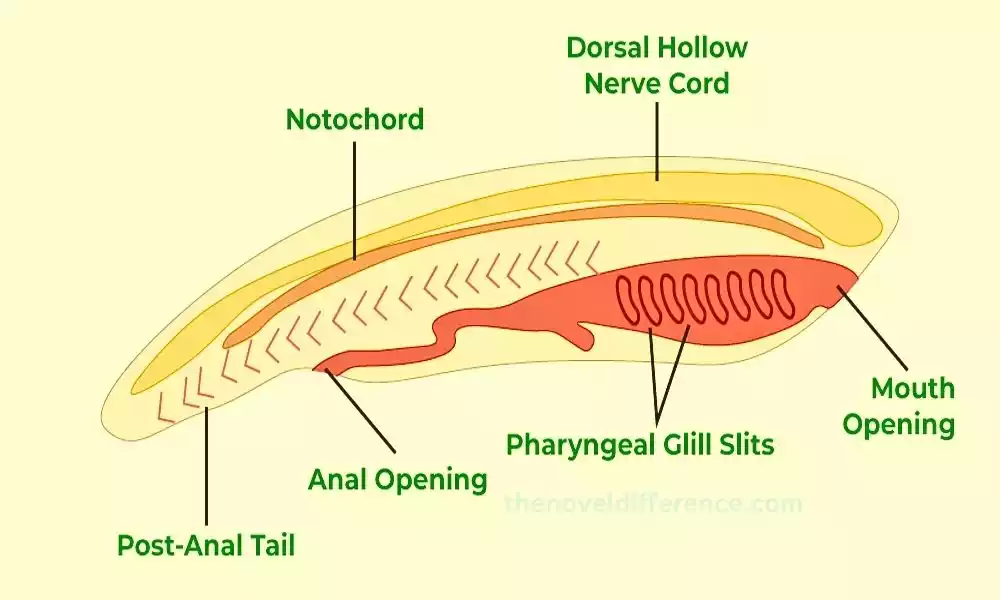
These features include:
Notochord: A flexible, rod-like structure that provides support and serves as a precursor to the vertebral column (spine) in vertebrates. The notochord is typically present during embryonic development and may persist in some species throughout their lives.
Dorsal Hollow Nerve Cord: A neural tube that runs along the dorsal (back) side of the body. As it matures, it forms the central nervous system – including the brain and spinal cord. In chordates, the nerve cord is located above the notochord.
Pharyngeal Slits or Pouches: Openings in the pharynx (throat) region. In some chordates, these slits or pouches serve as filter-feeding structures, while in others, they have evolved into gill structures for respiration. In more advanced chordates, such as vertebrates, these structures develop into various components of the head and neck region.
Post-anal Tail: An extension of the body beyond the anus. The tail may be present during embryonic development and can have various functions, including locomotion, balance, and propulsion in aquatic environments. Chordates exhibit a wide range of body plans and include diverse organisms.
They are traditionally classified into three subphyla:
Urochordata (Tunicates or Sea Squirts): Tunicates are often sessile filter feeders and exhibit a larval stage with all the chordate features, while the adult stage may have reduced or lost some of these characteristics.
Cephalochordata (Lancelets): Lancelets are small, fish-like marine animals that retain the characteristic chordate features throughout their lives. They live buried in sand and filter feed.
Vertebrata (Vertebrates): Vertebrates form one of the more familiar groups of chordates, including fish, amphibians, reptiles, birds, and mammals. They possess a well-developed vertebral column surrounding the notochord, a more complex nervous system, and a wide range of adaptations for different lifestyles.
Chordates exhibit remarkable diversity in terms of size, habitat, and ecological roles. Tierra plays an essential part in ecosystems and includes some of the most intelligent animals on Earth.
Characteristics of Chordates
Chordates are characterized by several distinct anatomical features that set them apart from other animal species.
These characteristics may be present at some stage in their life cycle and include:
Notochord: Chordates possess a notochord, which is a flexible rod-like structure used as support and as a precursor of vertebrate vertebral column/spine structures. It is typically found in the embryonic stage and may persist in some species throughout their lives.
Dorsal Hollow Nerve Cord: Chordates possess a dorsal hollow nerve cord, which is a neural tube located above the notochord. This nerve cord runs along your dorsal (back) side and connects directly with the central nervous system – including brain and spinal cord development.
Pharyngeal Slits or Pouches: Chordates have openings within their throat region known as pharyngeal slits or pouches that provide access to its vital functions, like breathing. These openings make breathing much simpler. These structures serve various functions depending on the species. In some chordates, such as fish, the slits develop into gills for respiration. In other chordates, like humans, they transform into components of the head and neck region, such as parts of the ear and throat.
Post-anal Tail: Chordates possess a post-anal tail, an extension of the body beyond the anus. The tail can be present during embryonic development and serves multiple purposes, including locomotion, balance, and propulsion in aquatic environments.
Note that while these characteristics may be characteristic of all chordates, not all display them equally. Some features may be more prominent in certain groups of chordates than in others. These features may only appear during specific points in their life cycles and could evolve or disappear as species develop and adapt to particular ecological niches.
What are Non-Chordates?
Non-chordates (more commonly referred to as invertebrates) represent an array of animals that do not display characteristics defining chordates, including spines. They lack a notochord, dorsal hollow nerve cord, pharyngeal slits or pouches, and a post-anal tail.
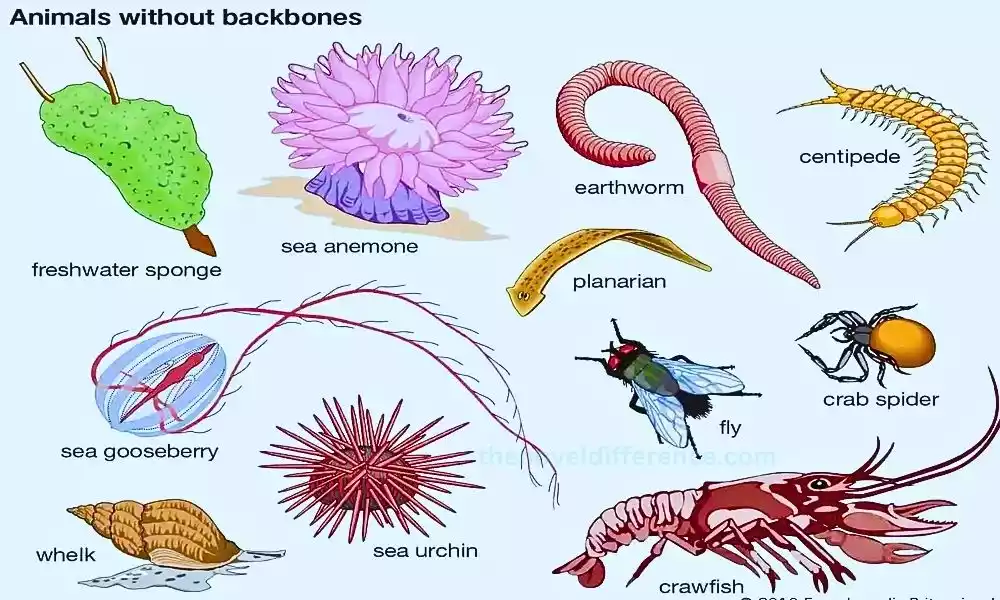
Non-chordates represent the vast majority of animal species on Earth and encompass a wide range of phyla, exhibiting diverse body plans, anatomical structures, and ecological roles.
Some major phyla of non-chordates include:
Porifera (Sponges): Simple multicellular organisms that lack true tissues and organs. They are filter feeders and often have a porous body structure.
Cnidaria (Jellyfish, corals, and sea anemones): Radially symmetric organisms characterized by specialized stinging cells called cnidocytes. They have a simple body plan with a central cavity and tentacles.
Platyhelminthes (Flatworms): Soft-bodied worms with a flattened body shape. They have a simple digestive system and lack a body cavity (coelom).
Annelida (Segmented worms): Worms characterized by a segmented body, with each segment containing specific organs and structures. Examples include earthworms and leeches.
Arthropoda (insects, crustaceans, and spiders): Arthropods form one of three major animal species, each distinguished by a segmented body with jointed appendages and an exoskeleton. Arthropods include insects, crustaceans, spiders, and other related organisms.
Mollusca (snails, squids, clams): A diverse group of organisms with a soft body often protected by a hard shell. Mollusks include gastropods (such as snails and slugs) bivalves (including clams, mussels, and oysters) cephalopods such as octopuses as well as cephalopods such as snails.
These are only some examples of non-chordate phyla, there are many more with their distinct features and adaptations. Non-chordates exhibit a wide range of ecological roles and have diverse body plans, locomotion methods, feeding strategies, and reproductive strategies. They play critical roles in various ecosystems and contribute to the incredible diversity of animal life on Earth.
Characteristics of Non-Chordates
Non-chordates, or invertebrates, exhibit a wide range of characteristics that distinguish them from chordates. While the features can vary among different phyla and species.
Some common features of non-chordates include:
Absence of Notochord: Non-chordates lack a notochord, which is a defining characteristic of chordates. Instead, they have different structural support systems, such as exoskeletons or hydrostatic skeletons.
Diverse Body Plans: Non-chordates display a vast array of body plans, ranging from simple and symmetrical to complex and asymmetrical. They can be cylindrical, flat, segmented, or possess various other body shapes.
External Skeletons or Exoskeletons: Non-chordate animals like arthropods can have external skeletons made up of either chitin or calcium carbonate for protection and support, similar to what human beings wear on their bones. These rigid structures provide support, and protection, and serve as attachment sites for muscles.
Various Locomotion Methods: Non-chordates employ diverse methods of locomotion, including crawling, swimming, burrowing, and flying. They may use legs, wings, cilia, or muscular contractions to move.
Radial Symmetry or Bilateral Symmetry: Non-chordates exhibit different types of body symmetry. Some organisms, like jellyfish (cnidarians), have radial symmetry, while others, like insects (arthropods) or worms (annelids), display bilateral symmetry.
Complex Reproductive Strategies: Non-chordates utilize a wide range of reproductive strategies. Sexual or asexual reproduction methods such as external fertilization, internal fertilization, hermaphroditism, or various forms of larval development all help facilitate reproduction in different ways.
Various Feeding Strategies: Non-chordates have diverse feeding strategies, including filter-feeding, predation, herbivory, scavenging, and parasitism. Different structures and adaptations are employed for capturing, consuming, and digesting food.
Lack of Advanced Nervous Systems: While non-chordates possess nervous systems, they are generally less complex than the central nervous systems found in chordates. Non-chordates may have ganglia, nerve nets, or simple nerve cords that allow for basic sensory perception and motor coordination.
It’s important to note that these characteristics can vary significantly across different non-chordate phyla, and exceptions exist within each group. The diversity of non-chordates is immense, with various adaptations and specialized traits allowing them to thrive in diverse environments and ecological niches.
Difference Between Chordates and Non-Chordates
The main differences between chordates and non-chordates (invertebrates) lie in their anatomical features, evolutionary history, and ecological roles.
Here are some key distinctions:
Notochord: Chordates possess a flexible rod-like structure that provides support and acts as a precursor to the vertebral column. Non-chordates lack a notochord and have different support systems like exoskeletons or hydrostatic skeletons.
Nervous System: Chordates have a dorsal hollow nerve cord, which develops into the central nervous system, including the brain and spinal cord. In non-chordates, the nervous system is typically less complex, with nerve cords, ganglia, or nerve nets depending on the group.
Pharyngeal Slits or Pouches: Chordates possess pharyngeal slits or pouches which act like breathing tubes for respiration purposes or play an integral part in shaping structures in their head and neck regions. Non-chordates generally lack these features, although some may have similar adaptations for filter-feeding or respiration.
Body Symmetry: Non-chordates display a variety of body symmetries, including radial symmetry in organisms like jellyfish and bilateral symmetry in others like insects or worms. Chordates, on the other hand, exhibit bilateral symmetry.
Reproductive Strategies: Chordates and non-chordates employ diverse reproductive strategies. Non-chordates often have a wide range of reproductive modes, including external fertilization, internal fertilization, asexual reproduction, or various forms of larval development. Chordates generally have internal fertilization and more complex reproductive strategies, with a greater diversity of specialized reproductive organs.
Taxonomy and Classification: Chordates and non-chordates belong to different major branches of the animal kingdom. Chordates belong to the phylum Chordata while non-chordates cover many phyla such as Porifera (sponges), Cnidaria (jellyfish and corals), Platyhelminthes (flatworms) or Arthropoda (insects and crustaceans), among many more.
Ecological Roles: Chordates and non-chordates play distinct ecological roles within ecosystems. Chordates, especially vertebrates, often occupy higher trophic levels and have complex interactions with their environment. Non-chordates, as invertebrates, perform essential ecological functions such as pollination, nutrient recycling, and habitat engineering.
These are some of the key differences between chordates and non-chordates, but it should be remembered that both groups contain great variability among them as there may be exceptions and variations within each phylum.
The study of these differences contributes to our understanding of animal diversity, evolution, and the ecological dynamics of ecosystems.
Similarities between chordates and Non-Chordates
While chordates and non-chordates (invertebrates) have significant differences, there are also some shared characteristics and similarities between the two groups.
Here are a few notable similarities:
Multicellularity: Both chordates and non-chordates are multicellular organisms composed of cells with specialization that perform various roles within their bodies.
Cellular Organization: Chordates and non-chordates exhibit similar cellular organization, with cells organized into tissues, organs, and organ systems. This allows for specialization and coordination of different physiological functions.
Presence of Nervous Systems: While the complexity of the nervous system differs, both chordates and non-chordates possess a nervous system. Non-chordates have simpler nervous systems, such as nerve nets or ganglia, while chordates have a more advanced central nervous system, including a brain and spinal cord.
Digestive System: Both chordates and non-chordates possess digestive systems designed to aid them in digesting food efficiently and absorbing essential vitamins from it. This typically includes a mouth, gut or digestive tract, and an anus or excretory opening.
Reproduction: Chordates and non-chordates reproduce through sexual reproduction, in which gametes (sperm and eggs) combine to form offspring. While the specific reproductive strategies and structures may differ, both groups have evolved various mechanisms to ensure the continuation of their species.
Sensory Systems: Chordates and non-chordates possess sensory systems that allow them to perceive and respond to their environment. Sensory organs include eyes, ears, and chemoreceptors which enable us to detect light, sound, chemicals, or any other stimuli in their environments.
Adaptation to Environment: Both chordates and non-chordates exhibit adaptations to their respective environments. These animals have evolved diverse forms, behaviors, and physiological adaptations that enable them to survive in various habitats and ecological niches.
Although similarities do exist between chordates and non-chordates, their anatomy, evolutionary history, and ecological roles differ considerably – creating the opportunity to gain greater insights into animal kingdom diversity and our own. Understanding both similarities and differences helps our collective knowledge about this unique species!
Evolutionary Significance of Chordates
Chordates hold significant evolutionary significance in the animal kingdom. Formation and expansion have played a critical role in shaping Earth’s evolutionary history.
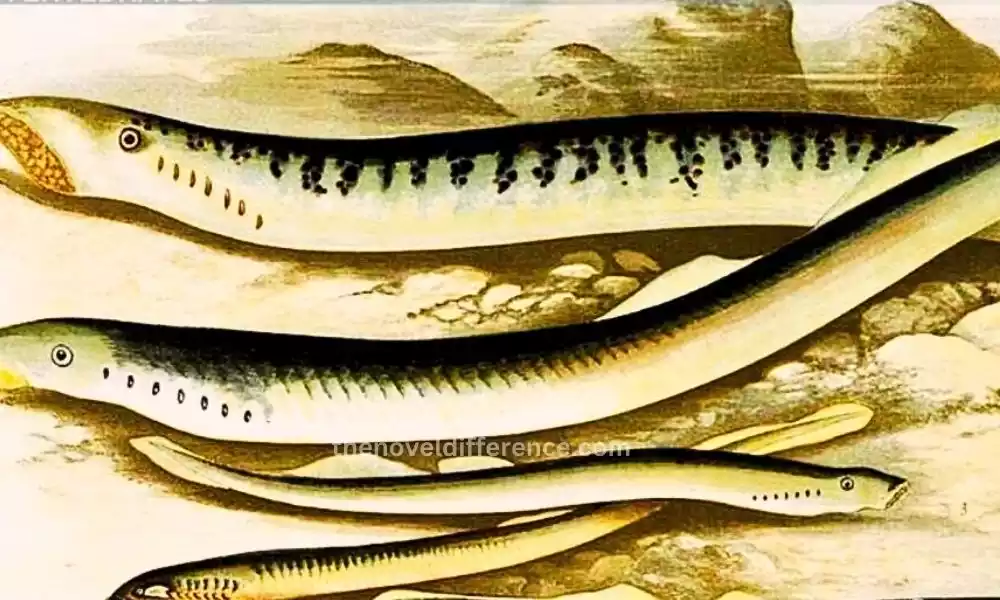
Some key evolutionary aspects of chordates include:
Origin of Vertebrates: Chordates include the subphylum Vertebrata, which comprises animals with a backbone or vertebral column. Vertebrates have marked an important juncture in life’s evolution. Possessing advanced sensory systems, a highly developed brain, and complex muscular-skeletal systems that enable them to adapt easily across diverse ecological niches and environments is hallmark evidence for vertebrate evolution.
Development of Advanced Nervous Systems: Chordates, including vertebrates, possess a dorsal hollow nerve cord that develops into the central nervous system. This evolutionary innovation allowed for the development of more sophisticated sensory perception, motor control, and cognitive abilities. The evolution of vertebrate brain and nervous systems has resulted in remarkable behaviors, learning capacities, and higher cognitive functions seen both among mammals and birds.
Evolution of Jaws and Limbs: The evolution of jaws in some early jawed fish during the early Paleozoic era opened up new possibilities for feeding and diversification. Jawed fish later gave rise to land-dwelling vertebrates, which ultimately led to the evolution of limbs and terrestrial adaptations. Limbed vertebrates – such as amphibians, reptiles, birds, and mammals – have successfully colonized various habitats while evolving specialized locomotor strategies to inhabit them.
Development of Complex Organs and Systems: Chordates have evolved complex organ systems, including the circulatory, respiratory, and digestive systems, allowing for efficient nutrient transport, gas exchange, and digestion. These advancements have contributed to the success and diversification of chordates in different environments.
Evolution of Chordate Features in Invertebrates: The presence of chordate features in some invertebrates, such as tunicates and lancelets, provides insights into the evolutionary origins of chordates. These organisms retain key characteristics like the notochord and dorsal hollow nerve cord, offering a glimpse into the early stages of chordate evolution.
Understanding the evolutionary significance of chordates allows us to trace the development and adaptation of complex anatomical structures, physiological processes, and behaviors seen in various vertebrate groups.
As well as offering context for investigating Earth’s evolving biodiversity and interdependent ecosystems, studying wildlife provides another framework to examine life in all of its forms on our planet and ecological interactions among different organisms.
Conclusion
The difference between chordates and non-chordates lies in their distinct anatomical features, evolutionary history, and ecological roles. Chordates are characterized by the presence of a notochord, dorsal hollow nerve cord, pharyngeal slits or pouches, and a post-anal tail.
They include diverse organisms, ranging from simple sea squirts and lancelets to complex vertebrates like fish, reptiles, birds, and mammals.
Non-chordates, or invertebrates, lack these specific features and encompass a vast array of animal phyla with diverse body plans, locomotion methods, feeding strategies, and reproductive modes.

